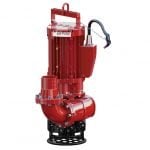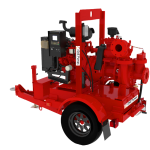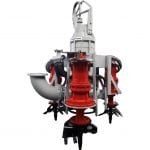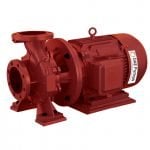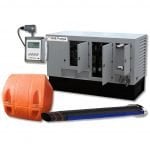Essential Considerations in Selecting a Slurry Pump
September 02, 2022

This article will provide information on the most critical factors when selecting a slurry pump for your application. First, you must ensure that the pump you purchase fits your specific application requirements. The selection of a slurry pump should include proper pump size, power requirements, slurry characteristics, and discharge head requirements.
To select the proper pump size, you must first determine the flow rate and head required by your application. The flow rate is the function of the speed of the pump and the impeller diameter. The head is a function of the impeller design, the number of impellers, the pump speed, and the fluid density.
This Article Includes
- Selecting The Right Slurry Pump
- What To Look for In a Slurry Pump
- DAE Pump’s Premium Heavy-Duty Pumps
Need Help?
Our team of engineers is standing by to help you with your next project. Call us at (760) 821-8112 or submit a request.
Selecting the right Slurry Pump
Many pumps can be found on the market, but most are specifically designed to serve a particular purpose. Pumps designed to move thin fluids differ from pumps designed for heavy, thick-laden, abrasive, or abrasive materials. Because of the differences in the design of various pumps, you must choose the right pump for the application. For example, if you need to move much liquid quickly, you will want to select a pump with a high flow rate. However, if you are forcing a liquid with many solids, you want to use a pump. Pumps come in many different varieties, each designed for a specific purpose. For example, if you are trying to move water with much sand, you would want to use a centrifugal pump.
The slurry pump moves thick materials such as slurries and gravel. As the name suggests, a slurry is an amalgamation of two or more materials, such as water and crushed rock. Slurry pumps can move thick materials from their source to the pump and downstream to the destination. This is done using a high-pressure water stream to push the slurry through a pipe. The slurry is then forced through a series of valves and into the pump.
Because of their nature, slurry pumps can pump high-viscous and solid-laden liquids without clogging. Slurry pumps are distinguished by their ability not to choke. They can be used in extreme environments, such as mining and oil and gas extraction, and are also helpful in other sectors, including dredging and oil and gas. Dredging removes sediment and debris from the bottom of bodies of water and is often used to maintain shipping channels.

DAE Pumps: Industrial Slurry Pumps and Dredging Equipment
Check Out DAE Pumps Other Products
What to Look for in a Slurry Pump
These seven key considerations will assist you in determining the most suitable pump for your specific application. Because these factors are more significant than the pump’s viscosity or specific gravity, selecting the best-suited pump is more challenging. The factors that must be considered include the temperature and density of the fluid, the required flow rate, the head, the NPSH available, the suction conditions, the discharge conditions, and the mechanical design of the pump.
- You can choose the material you want to pump (sand, sludge, mud, water, slurry, etc.). The characteristics of each material are crucial in choosing suitable slurry pumps.
- The density of the material to be pumped specific gravity – 2.5 Sg etc.
- The viscosity of the material to pump 1,000 centipoises (CPS), etc.
- Temperature of operation
- The pH level – pH measures hydrogen-ion concentration. The pH level can be easily remembered by simply remembering that 7 pH equals neutral. Below 7 acids is 7 alkaline. The pH range between 4 to 9 is best suited for high-chrome steel. The best pH level for duplex stainless is between 3 and 10.
- Rate of flow required. yards/hour [cu-yd/h]
- Discharge Head (example: 100 PSIG).
- You must ensure that your pump can discharge more water than the required total head. This will reduce potential damage to both the pump and the discharge pipeline.
- The length of the discharge and inlet pipelines (example: 1,000 ft.)
- Diameter of discharge and inlet pipelines (examples: 4-in. 10-in. etc.).
- Materials used in pipeline construction include steel, polyvinyl chloride, and cast iron.
- The elevation of the pump in relation to the fluid source
- Flooded Suction (pump placed under fluid source).
- Submersible suction is a pump that’s inserted within a fluid source.
- The pump must be self-priming for elevated suction.
DAE Pump’s Premium Heavy-Duty Pumps
The DAE Pump has long been regarded as one of the most reliable self-priming pumps with high specific gravity and viscosity. It is specifically designed for applications that transfer heavy, abrasive, or solid-laden materials. The pump’s non-clogging design includes an extended wetted path with an open rotor. The pump can move large amounts of viscous material without clogging or downtime. The pump is also self-priming, meaning it can start and stop without any issue. The pump can also run dry without any damage to the pump itself.
Meager cost of ownership
Choosing the right pump for you is not just about whether it meets your requirements. It also considers the cost of ownership and the total amount of time your pump will use. The DAE Pump can pump viscous or high-specific gravity materials that have a volume exceedingly high in solids. This reduces the overall cost of pumping the material. Pumps that use high amounts of water to move viscous material can significantly reduce profit margins. This is because the water can quickly break down the pump’s seals and bearings, leading to extensive repairs that can be very costly. The high-water content in the material can also lead to clogging and other issues that can reduce the system’s efficiency.
Materials of Construction
The DAE Pump is constructed from the finest materials. It is very rugged and abrasion-resistant, chemically compatible with most fluids, and can withstand all that’s often involved in the abrasive and high-viscosity applications to expand and contract, which can lead to clogging and other problems—causing the material to expand and contract block, and other issues. The expansion and contraction can also cause the material to become clogged, leading to other problems.
DAE Pumps – Going Above and Beyond!
DAE Pumps is a premium industrial slurry pumps and dredge equipment manufacturer. Offering unparalleled performance for many different industries, DAE Pumps are ideally suited for Oil & Gas, Mining, Construction, Marine, Municipal, Water & Wastewater, and many other industries. Along with the high-quality pumps DAE Pumps offers, we also provide world-class service to assist you no matter what the pumping challenge.
DAE Pumps Product Categories
All pumps by DAE Pumps are made of the highest quality materials; they are durable, long-lasting, and provide value beyond your expectations. No matter your industry, DAE Pumps has a pump specifically suited for your needs.
Need Help?
Our team of engineers is standing by to help you with your next project. Call us at (760) 821-8112 or submit a request.



